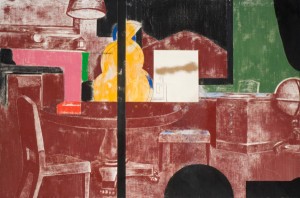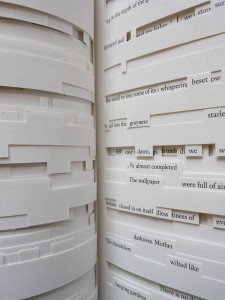I am impressed above all with R.B. Kitaj’s collage-like works, produced by superimposing numerous pieces of information and artistic citations. With their powerful colors, they radiate at first a kind of lightness and beauty.

R.B. Kitaj, Desk Murder 1970–1984 © Birmingham, Birmingham Museum and Art Gallery
The actual stories behind the motifs become clear only when one reads the texts that Kitaj attached to his pictures. These additional levels turn the collages into fraught projection screens for personal, historical, political, cultural, and religious themes and events. Suddenly text and image can no longer be viewed and understood separately. A putatively beautiful, gaily colored work becomes a vexating puzzle. → continue reading
Searching for a Jewish past is the topic of Jonathan Safran Foer’s Tree of Codes. His best-selling, Hollywood-adapted debut novel Everything is Illuminated (2002) already depicted a young man on a trip to the Ukraine in search of his family’s past.  His new book is also a search for Jewish roots, though this time artistic, rather than biographical.
His new book is also a search for Jewish roots, though this time artistic, rather than biographical.
Experimenting with the concept of absence, the book reproduces parts of Bruno Schulz’s Street of Crocodiles, the English translation of one of two surviving texts of a writer, whose other works were lost when the National Socialists seized his Polish hometown Drohobycz in 1941 and murdered its citizens, including Schulz, in 1942. As if to depict the loss of literature by destroying the letters in a book, Foer cut into Schulz’s pages, leaving only select words and half sentences behind, thereby reducing, already in its title, Street of Crocodiles to Tree of Codes. → continue reading
Migration is a topic of increasing importance for museums, including our own. A conference taking place today in Newcastle (UK) as part of the European Museums in an Age of Migrations (MeLA) project looks specifically at museum displays as they adapt to show social interaction in greater complexity: www.mela-project.eu/events/details/-placing-europe-in-the-museum-people-s-places-identities

